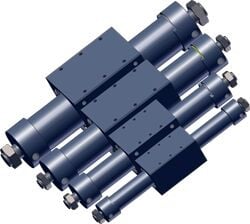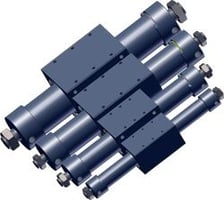
 Once you have decided that pneumatic actuators are the best choice for your industrial automation project, you still have a critical design decision to make: which type? Should you use cable, magnetically coupled, or band type rodless cylinders?
Once you have decided that pneumatic actuators are the best choice for your industrial automation project, you still have a critical design decision to make: which type? Should you use cable, magnetically coupled, or band type rodless cylinders?
Pneumatic actuators are often the most cost-effective solution when you want to create linear motion. Single-acting or double-acting cylinders can be used to accomplish the task:
- Single-acting cylinders rely on a pneumatic “push” to move the piston, then use gravity or an internal spring to return the piston to its original position. This is an efficient design choice for one-way tasks – stamping an object into something, or lifting an object, for instance.
- Double-acting cylinders actively use pressure to move the piston both forward and back. This is the most effective choice for tasks such as opening and closing a door or gate or moving a squeegee head.
Pneumatic actuators are suitable for numerous types of industrial and commercial applications, from production plant machinery to car washes. They use gas, not a fluid, to create operational pressure, which eliminates any chance of dripping leakage that could contaminate food products or the general surroundings, for instance.
Many pneumatic actuators are designed and manufactured to withstand harsh working environments where high-pressure washdowns, caustic chemicals, etc. are prevalent. For example, the piston on a magnetic coupled cylinder is completely enclosed in a sealed tube, protecting it from any of these environmental hazards.
W.C. Branham manufactures four types of pneumatic actuators:
- DURATRK™ Rodless Band Cylinders
- MAGTEC® Magnetically Coupled Rodless Cylinders
- pneU-SA® Rodless Enclosed Cable Cylinders
- Rodless Cable Cylinders (Non Guided and Guided)
That makes it easy to find the configuration you want, in the bore size and stroke length you need. Tight on space? Our pneumatic actuators can also deliver a significantly smaller machine footprint than traditional cylinders, because they stroke along their body length and are typically take up 45% less space than a traditional NFPA type cylinder.
Considerations for choosing the right pneumatic actuators
The actuator requires a certain minimum pressure and flow to work properly, and at the desired speed. But actuators are the final component in a working system that starts with compressors and includes hoses, filters, lubricators, and controls for valves and overall air flow. That means these other system components must be sized to deliver optimum pressure and flow. Otherwise, actuator efficiency could be compromised. It’s important to bear in mind that pressure and/or flow will drop off to some degree before reaching the actuator.
Mounting configuration also affects the actuator’s performance. In addition, your application may also require customized design options such as special seals or cushions that absorb energy at the end of each stroke. External shock absorbers can be especially valuable when the application involves high speed or fast cycle rates.
Questions to ask yourself
Essentially, you should determine your rodless cylinder needs by defining the application. You can start by asking yourself the following questions:
- What is the desired stroke length?
- How heavy is the load I am trying to move?
- Will the load be externally guided and supported or must the rodless cylinder guide and support the moving load?
- Will the cylinder be mounted horizontally with the cylinder carrier up or down? Or will the cylinder be mounted vertically or at an incline?
- What is the desired speed?
- What type of ambient environment will the cylinder be located in?
- Is the envelope large enough to fit a rodless cylinder?
Knowing the answers to these questions is a good starting point in selecting the right rodless cylinder for your application.
Whether you’re stumped about choosing pneumatic actuators or you just have a question about your application, let’s talk. Our design and engineering experts at W.C. Branham are professional problem-solvers, and we’re here to help.


